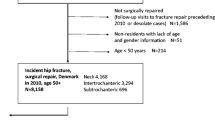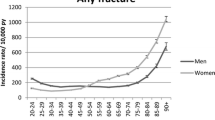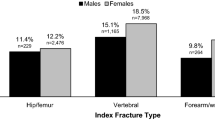Abstract
Summary
We investigated the association of objectively ascertained sibling fracture history with major osteoporotic fracture (hip, forearm, humerus, or clinical spine) risk in a population-based cohort using administrative databases. Sibling fracture history is associated with increased major osteoporotic fracture risk, which has implications for fracture risk prediction.
Introduction
We aimed to determine whether objectively ascertained sibling fracture history is associated with major osteoporotic fracture (MOF; hip, forearm, humerus, or clinical spine) risk.
Methods
This retrospective cohort study used administrative databases from the province of Manitoba, Canada, which has a universal healthcare system. The cohort included men and women 40+ years between 1997 and 2015 with linkage to at least one sibling. The exposure was sibling MOF diagnosis occurring after age 40 years and prior to the outcome. The outcome was incident MOF identified in hospital and physician records using established case definitions. A multivariable Cox proportional hazards regression model was used to estimate the risk of MOF after adjustment for known fracture risk factors.
Results
The cohort included 217,527 individuals; 91.9% were linked to full siblings (siblings having the same father and mother) and 49.0% were females. By the end of the study period, 6255 (2.9%) of the siblings had a MOF. During a median follow-up of 11 years (IQR 5–15), 5235 (2.4%) incident MOF were identified in the study cohort, including 234 hip fractures. Sibling MOF history was associated with an increased risk of MOF (hazard ratio [HR] 1.67, 95% confidence interval [CI] 1.44–1.92). The risk was elevated in both men (HR 1.57, 95% CI 1.24–1.98) and women (HR 1.74, 95% CI 1.45–2.08). The highest risk was associated with a sibling diagnosis of forearm fracture (HR 1.81, 95% CI 1.53–2.15).
Conclusion
Sibling fracture history is associated with increased MOF risk and should be considered as a candidate risk factor for improving fracture risk prediction.



Similar content being viewed by others
Data availability
Study data were from the Manitoba Population Research Data Repository housed at the Manitoba Centre for Health Policy, University of Manitoba. These data are not publicly available. In order to access Repository data, an individual must prepare a proposal, complete an accreditation process, obtain ethical and data access approval, and complete a researcher agreement with the provincial ministry of health.
References
Unnanuntana A, Gladnick BP, Donnelly E, Lane JM (2010) The assessment of fracture risk. J Bone Joint Surg Am 92:743–753
Odén A, McCloskey EV, Kanis JA, Harvey NC, Johansson H (2015) Burden of high fracture probability worldwide: secular increases 2010–2040. Osteoporos Int 26:2243–2248
NIH Consensus Development Panel on Osteoporosis Prevention D (2001) Osteoporosis prevention, diagnosis, and therapy. JAMA 285:785–795
Boonen S, Autier P, Barette M, Vanderschueren D, Lips P, Haentjens P (2004) Functional outcome and quality of life following hip fracture in elderly women: a prospective controlled study. Osteoporos Int 15:87–94
Chiu M-H, Hwang H-F, Lee H-D, Chien D-K, Chen C-Y, Lin M-R (2012) Effect of fracture type on health-related quality of life among older women in Taiwan. Arch Phys Med Rehabil 93:512–519
Lyles KW, Gold DT, Shipp KM, Pieper CF, Martinez S, Mulhausen PL (1993) Association of osteoporotic vertebral compression fractures with impaired functional status. Am J Med 94:595–601
Bonar SK, Tinetti ME, Speechley M, Cooney LM (1990) Factors associated with short- versus long-term skilled nursing facility. J Am Geriatr Soc 38:1139–1144
Cummings SR, Melton LJ (2002) Epidemiology and outcomes of osteoporotic fractures. Lancet 359:1761–1767
Shoback D, Rosen CJ, Black DM, Cheung AM, Murad MH, Eastell R (2020) Pharmacological management of osteoporosis in postmenopausal women: an Endocrine Society guideline update. J Clin Endocrinol Metab 105:587–594
Papaioannou A, Morin S, Cheung AM, Atkinson S, Brown JP, Feldman S, Hanley DA, Hodsman A, Jamal SA, Kaiser SM, Kvern B, Siminoski K, Leslie WD, for the Scientific Advisory Council of Osteoporosis Canada (2010) 2010 clinical practice guidelines for the diagnosis and management of osteoporosis in Canada: summary. CMAJ 182:1864–1873
Lentle B, Cheung AM, Hanley DA, Leslie WD, Lyons D, Papaioannou A, Atkinson S, Brown JP, Feldman S, Hodsman AB, Jamal AS, Josse RG, Kaiser SM, Kvern B, Morin S, Siminoski K, Scientific Advisory Council of Osteoporosis Canada (2011) Osteoporosis Canada 2010 guidelines for the assessment of fracture risk. Can Assoc Radiol J 62:243–250
Adler RA, Fuleihan GE-H, Bauer DC et al (2016) Managing osteoporosis in patients on long-term bisphosphonate treatment: report of a task force of the American Society for Bone and Mineral Research. J Bone Miner Res 31:16–35
Kanis JA, Cooper C, Rizzoli R, Reginster J-Y (2019) European guidance for the diagnosis and management of osteoporosis in postmenopausal women. Osteoporos Int 30:3–44
Yang S, Leslie WD, Yan L, Walld R, Roos LL, Morin SN, Majumdar SR, Lix LM (2016) Objectively verified parental hip fracture is an independent risk factor for fracture: a linkage analysis of 478,792 parents and 261,705 offspring. J Bone Miner Res 31:1753–1759
Yang S, Leslie WD, Walld R, Roos LL, Morin SN, Majumdar SR, Lix LM (2017) Objectively-verified parental non-hip major osteoporotic fractures and offspring osteoporotic fracture risk: a population-based familial linkage study. J Bone Miner Res 32:716–721
Hippisley-Cox J, Coupland C (2009) Predicting risk of osteoporotic fracture in men and women in England and Wales: prospective derivation and validation of QFractureScores. BMJ 339:b4229
Jackson RD, Donepudi S, Mysiw WJ (2008) Epidemiology of fracture risk in the Women’s Health Initiative. Curr Osteoporos Rep 6:155–161
Kanis JA, Johnell O, Oden A, Johansson H, McCloskey E (2008) FRAX™ and the assessment of fracture probability in men and women from the UK. Osteoporos Int 19:385–397
Robbins J, Aragaki AK, Kooperberg C, Watts N, Wactawski-Wende J, Jackson RD, LeBoff MS, Lewis CE, Chen Z, Stefanick ML, Cauley J (2007) Factors associated with 5-year risk of hip fracture in postmenopausal women. JAMA 298:2389–2398
Keen RW, Hart DJ, Arden NK, Doyle DV, Spector TD (1999) Family history of appendicular fracture and risk of osteoporosis: a population-based study. Osteoporos Int 10:161–166
Fox KM, Cummings SR, Powell-Threets K, Stone K (1998) Family history and risk of osteoporotic fracture. Study of Osteoporotic Fractures Research Group. Osteoporos Int 8:557–562
Seeley DG, Kelsey J, Jergas M, Nevitt MC (1996) Predictors of ankle and foot fractures in older women. J Bone Miner Res 11:1347–1355
Sirola J, Salovaara K, Tuppurainen M, Jurvelin JS, Alhava E, Kröger H (2009) Sister’s fracture history may be associated with perimenopausal bone fragility and modifies the predictability of fracture risk. Osteoporos Int 20:557–565
Kanis JA, Johansson H, Oden A, Johnell O, de Laet C, Eisman JA, McCloskey EV, Mellstrom D, Melton LJ III, Pols HAP, Reeve J, Silman AJ, Tenenhouse A (2004) A family history of fracture and fracture risk: a meta-analysis. Bone 35:1029–1037
Baleanu F, Moreau M, Kinnard V, Iconaru L, Karmali R, Paesmans M, Bergmann P, Body JJ (2020) What is the validity of self-reported fractures? Bone Rep 12:100256
University of Manitoba - Faculty of Medicine - Community Health Sciences - Manitoba Centre for Health Policy - Manitoba Population Research Data Repository - Overview. http://www.umanitoba.ca/faculties/health_sciences/medicine/units/chs/departmental_units/mchp/resources/repository/index.html. Accessed 5 Mar 2020
Bolton JM, Au W, Chateau D, Walld R, Leslie WD, Enns J, Martens PJ, Katz LY, Logsetty S, Sareen J (2016) Bereavement after sibling death: a population-based longitudinal case-control study. World Psychiatry 15:59–66
Roos LL, Hiebert B, Manivong P, Edgerton J, Walld R, MacWilliam L, de Rocquigny J (2013) What is most important: social factors, health selection, and adolescent educational achievement. Soc Indic Res 110:385–414
Roos LL, Walld R, Witt J (2014) Adolescent outcomes and opportunities in a Canadian province: looking at siblings and neighbors. BMC Public Health 14:1–16
University of Manitoba - Faculty of Medicine - Community Health Sciences - Manitoba Centre for Health Policy - Concept Dictionary and Glossary for Population Based Research. http://mchp-appserv.cpe.umanitoba.ca/viewConcept.php?conceptID=1141. Accessed 12 Jun 2020
Roos L, Walld R, Burchill C, Nickel N, Roos NP (2017) Linkable administrative files: family information and existing data. Longitud Life Course Stud 8:264–280
Bolton JM, Au W, Leslie WD, Martens PJ, Enns MW, Roos LL, Katz LY, Wilcox HC, Erlangsen A, Chateau D, Walld R, Spiwak R, Seguin M, Shear K, Sareen J (2013) Parents bereaved by offspring suicide: a population-based longitudinal case-control study. JAMA Psychiatry 70:158–167
Vala CH, Odén A, Lorentzon M, Sundh V, Johansson H, Karlsson M, Rosengren B, Ohlsson C, Johansson B, Kanis J, Mellström D (2017) Increased risk of hip fracture among spouses-evidence of a homogamy effect. Osteoporos Int 28:95–102
Lix LM, Azimaee M, Osman BA, Caetano P, Morin S, Metge C, Goltzman D, Kreiger N, Prior J, Leslie WD (2012) Osteoporosis-related fracture case definitions for population-based administrative data. BMC Public Health 12:301
Mustard CA, Derksen S, Berthelot JM, Wolfson M (1999) Assessing ecologic proxies for household income: a comparison of household and neighbourhood level income measures in the study of population health status. Health Place 5:157–171
Leslie WD, Lix LM, Johansson H, Oden A, McCloskey E, Kanis JA, Manitoba Bone Density Program (2010) Independent clinical validation of a Canadian FRAX tool: fracture prediction and model calibration. J Bone Miner Res 25:2350–2358
Sargent DJ (1998) A general framework for random effects survival analysis in the Cox proportional hazards setting. Biometrics 54:1486–1497
Kannus P, Palvanen M, Kaprio J, Parkkari J, Koskenvuo M (1999) Genetic factors and osteoporotic fractures in elderly people: prospective 25 year follow up of a nationwide cohort of elderly Finnish twins. BMJ 319:1334–1337
Estrada K, Styrkarsdottir U, Evangelou E, Hsu YH, Duncan EL, Ntzani EE, Oei L, Albagha OME, Amin N, Kemp JP, Koller DL, Li G, Liu CT, Minster RL, Moayyeri A, Vandenput L, Willner D, Xiao SM, Yerges-Armstrong LM, Zheng HF, Alonso N, Eriksson J, Kammerer CM, Kaptoge SK, Leo PJ, Thorleifsson G, Wilson SG, Wilson JF, Aalto V, Alen M, Aragaki AK, Aspelund T, Center JR, Dailiana Z, Duggan DJ, Garcia M, Garcia-Giralt N, Giroux S, Hallmans G, Hocking LJ, Husted LB, Jameson KA, Khusainova R, Kim GS, Kooperberg C, Koromila T, Kruk M, Laaksonen M, Lacroix AZ, Lee SH, Leung PC, Lewis JR, Masi L, Mencej-Bedrac S, Nguyen TV, Nogues X, Patel MS, Prezelj J, Rose LM, Scollen S, Siggeirsdottir K, Smith AV, Svensson O, Trompet S, Trummer O, van Schoor NM, Woo J, Zhu K, Balcells S, Brandi ML, Buckley BM, Cheng S, Christiansen C, Cooper C, Dedoussis G, Ford I, Frost M, Goltzman D, González-Macías J, Kähönen M, Karlsson M, Khusnutdinova E, Koh JM, Kollia P, Langdahl BL, Leslie WD, Lips P, Ljunggren Ö, Lorenc RS, Marc J, Mellström D, Obermayer-Pietsch B, Olmos JM, Pettersson-Kymmer U, Reid DM, Riancho JA, Ridker PM, Rousseau F, lagboom PES, Tang NLS, Urreizti R, van Hul W, Viikari J, Zarrabeitia MT, Aulchenko YS, Castano-Betancourt M, Grundberg E, Herrera L, Ingvarsson T, Johannsdottir H, Kwan T, Li R, Luben R, Medina-Gómez C, Th Palsson S, Reppe S, Rotter JI, Sigurdsson G, van Meurs JBJ, Verlaan D, Williams FMK, Wood AR, Zhou Y, Gautvik KM, Pastinen T, Raychaudhuri S, Cauley JA, Chasman DI, Clark GR, Cummings SR, Danoy P, Dennison EM, Eastell R, Eisman JA, Gudnason V, Hofman A, Jackson RD, Jones G, Jukema JW, Khaw KT, Lehtimäki T, Liu Y, Lorentzon M, McCloskey E, Mitchell BD, Nandakumar K, Nicholson GC, Oostra BA, Peacock M, Pols HAP, Prince RL, Raitakari O, Reid IR, Robbins J, Sambrook PN, Sham PC, Shuldiner AR, Tylavsky FA, van Duijn CM, Wareham NJ, Cupples LA, Econs MJ, Evans DM, Harris TB, Kung AWC, Psaty BM, Reeve J, Spector TD, Streeten EA, Zillikens MC, Thorsteinsdottir U, Ohlsson C, Karasik D, Richards JB, Brown MA, Stefansson K, Uitterlinden AG, Ralston SH, Ioannidis JPA, Kiel DP, Rivadeneira F (2012) Genome-wide meta-analysis identifies 56 bone mineral density loci and reveals 14 loci associated with risk of fracture. Nat Genet 44:491–501
Michaëlsson K, Melhus H, Ferm H, Ahlbom A, Pedersen NL (2005) Genetic liability to fractures in the elderly. Arch Intern Med 165:1825–1830
Peacock M, Turner CH, Econs MJ, Foroud T (2002) Genetics of osteoporosis. Endocr Rev 23:303–326
MacGregor AJ, Snieder H, Spector TD (2000) Genetic factors and osteoporotic fractures in elderly people. BMJ 320:1669
Slemenda CW, Christian JC, Williams CJ, Norton JA, Johnston CC (1991) Genetic determinants of bone mass in adult women: a reevaluation of the twin model and the potential importance of gene interaction on heritability estimates. J Bone Miner Res 6:561–567
Acknowledgments
We acknowledge the Manitoba Centre for Health Policy for use of data contained in the Population Health Research Data Repository (HIPC #: 2008/2009-16; MCHP Project #: 2009-008). The results and conclusions are those of authors, and no official endorsement by the Manitoba Centre for Health Policy, Manitoba Health, Healthy Living, and Seniors, or other data providers is intended or should be inferred.
Funding
This study was supported by funding from the Canadian Institute of Health Research (Grant # FRN 151726). LML is supported by a Tier 1 Canada Research Chair.
Author information
Authors and Affiliations
Contributions
Authors substantially contributed to conception, design, and analysis (AFH, LML, WDL, RW, LY, SY, LRL); interpretation of data (all authors); drafting the article (AFH, LML, LY); critically revising the article for important intellectual content (all authors); and final approval of the version to be published (all authors).
Corresponding author
Ethics declarations
Conflicts of interest
SNM has received research funding from Amgen Canada. AFH, SY, LY, WDL, RW, LLR, and LML declare that they have no conflict of interest.
Ethics approval
The study was approved by the Health Research Ethics Board of the University of Manitoba; data access approval was provided by the Manitoba Health Information Privacy Committee.
Code availability
The SAS codes used to generate the results can be made available to editors and reviewers upon request.
Additional information
Publisher’s note
Springer Nature remains neutral with regard to jurisdictional claims in published maps and institutional affiliations.
Rights and permissions
About this article
Cite this article
Hamad, A., Yang, S., Yan, L. et al. The association of objectively ascertained sibling fracture history with major osteoporotic fractures: a population-based cohort study. Osteoporos Int 32, 681–688 (2021). https://doi.org/10.1007/s00198-020-05635-2
Received:
Accepted:
Published:
Issue Date:
DOI: https://doi.org/10.1007/s00198-020-05635-2




